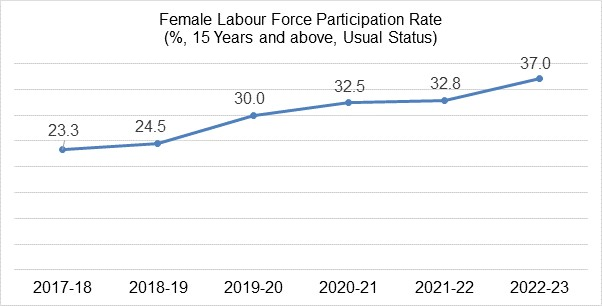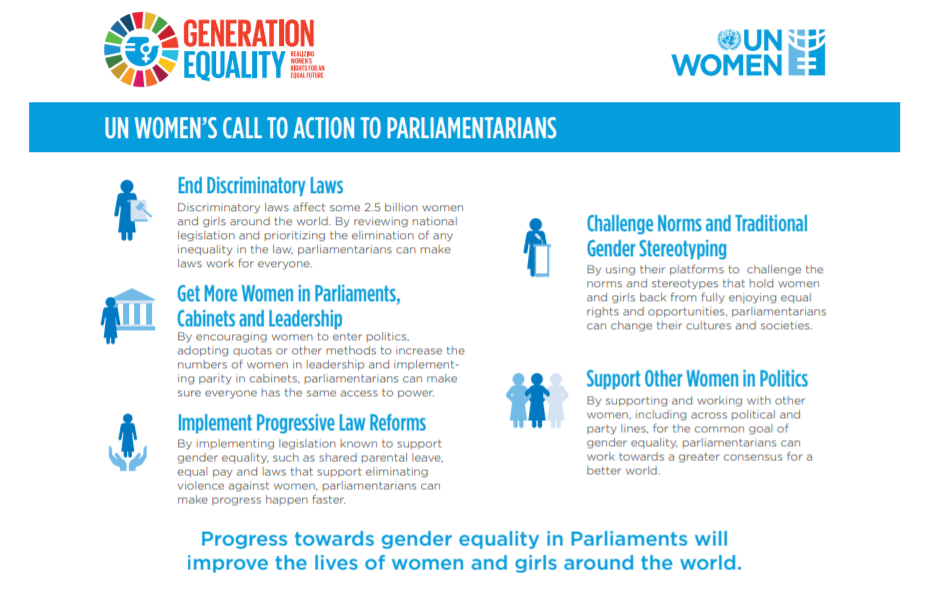Indian Society
Perspective: Women-Led Development
- 11 Jan 2024
- 8 min read
For Prelims: G-20, Inclusive Growth, Sustainable Development, Monetary Policy, Fiscal Policy, Women Reservation Act, Stand-Up India, PM MUDRA Yojana, Beti Bachao Beti Padhao, PM Jan Dhan Yojana, National Rural Livelihood Mission, PM Awas Yojana, Maternity Leave.
For Mains: About Women-led development, Gender becoming one of the top of India's Priorities, Challenges in Implementing Women-Led Development in India, Indian Vision of Women-Led Development.
What is the Context?
Recently, India designated "women-led development" as one of the six central focal points during its G20 presidency, alongside inclusive growth, advancement of Sustainable Development Goals, environmentally friendly development, technological innovation, and the restructuring of multilateral institutions, it symbolized a subtle recognition of the enduring significance of addressing gender equality as a prominent policy concern within India.
What is Women-led Development?
- "Women-led development" refers to a development approach where women take on leading roles and actively participate in shaping and driving the economic, social, and political progress of a society or community.
- Under women-led development, women are not just beneficiaries of development, instead, they set the agenda for development and are key participants in development planning and decision-making as leaders and equal participants.
- This includes a focus on bringing women to the fore, and in leading positions, to boost socio-economic development and achievement of SDGs.
- This approach recognizes the importance of gender equality and aims to break down barriers that have historically limited women's participation and contributions in various aspects of development.
Why has Gender Become One of the Top of India's Priorities?
- Wide Gender Gap: India was ranked 127 out of 146 countries in the Global Gender Gap Report, 2023. and faces the perennial issue of “missing women” from the workforce – which is a wicked problem.
- Inclusive Decision-Making: Women-led development promotes inclusive decision-making structures that involve women in community planning, resource allocation, and policy formulation. This inclusivity helps address diverse needs and perspectives within the community.
- Community Development: When women have access to resources, they invest in the education and health of families and communities, more than men. Women in Panchayati Raj Institutions have initiated and implemented various community development projects. This includes initiatives related to water management, sanitation, rural infrastructure, and poverty alleviation.
- Sustainable Development: Women-led development tends to be aligned with sustainable development goals. By promoting practices that are environmentally friendly and socially responsible, these initiatives contribute to the long-term well-being of the community.
- Multiplier effect -There is a multiplier effect of women-led development on the Indian economy. According to a McKinsey report, India can add up to 18% to its GDP provided it bridges its gender equality gap by improving female workforce participation in the country.
What are the Key Challenges in Implementing Women-Led Development?
- Deep-Seated Patriarchy: India has deeply ingrained patriarchal norms and societal structures that hinder women's empowerment and leadership. Changing these cultural attitudes and behaviors is a substantial challenge.
- Gender-Based Violence: India has one of the highest rates of violence against women in the world. According to the National Crime Records Bureau (NCRB), in 2021, a total of 4,05,861 cases of crimes against women were reported in India, of which 32,033 cases were of rape.
- Resource Allocation: Allocating resources for women-led development initiatives and ensuring they reach the intended beneficiaries can be challenging due to administrative inefficiencies and corruption.
- The Agriculture Census shows women land owners constituted only 13.9% in 2015–16.
- Political Underrepresentation: Women are underrepresented in political roles, including at the local level. Encouraging greater political participation by women is a challenge.
- Only 82 women members of parliament in India, in LS (15.2%) and RS (13%).
- Data Collection and Analysis: Reliable data on the status of women and the impact of policies can be challenging to collect and analyze, making it difficult to measure progress.
- Legal Enforcement: While India has enacted various laws to protect women's rights, the enforcement of these laws can be inconsistent, posing a challenge to justice and accountability.
What are the Government Initiatives Pushing Women Led Development?
- Women Reservation Act
- Stand-Up India
- PM MUDRA Yojana
- Beti Bachao Beti Padhao
- PM Jan Dhan Yojana
- National Rural Livelihood Mission
- PM Awas Yojana
- Maternity Leave
What Should be the Way Forward?
- Leadership and Decision-Making: India should aim to promote women's leadership and active participation in political systems and governance, with a specific focus on women at grassroots levels.
- Education and Skilling: India should emphasize increasing investment in and access to education for women, particularly in STEM fields.
- Empowering Women Entrepreneurs: There should be a consistent focus on promoting women entrepreneurs and supporting women-owned and women-led Micro, Small, and Medium Enterprises (MSMEs).
- Recognizing Invisible Work: There is a need to invest significantly in the care economy and social protection and redefine Gross Domestic Product to make work in the home visible and counted.
- Women's Roles in Climate and Food Security: India should highlight the importance of women's involvement in building a climate resilience ecosystem. Recognize and promote women's role in addressing climate change, food security, and nutrition.
- Changing Mindsets: To achieve women-led development in India, it is essential to shift societal mindsets. Creating awareness and promoting education are crucial for instilling behaviours that value and empower women's leadership.
Conclusion
India's pursuit of a progressive and gender-equal society requires more than just political commitments; actualizing women-led development necessitates fulfilling equal opportunities and basic needs. Fostering women's leadership at all levels is crucial for achieving inclusive and sustainable development in the country.
UPSC Civil Services Examination Previous Year Question (PYQ)
Prelims
Q. Which of the following gives the ‘Global Gender Gap Index’ ranking to the countries of the world? (2017)
(a) World Economic Forum
(b) UN Human Rights Council
(c) UN Women
(d) World Health Organization
Ans: A
Mains:
Q. How does patriarchy impact the position of middle-class working women in India? (2014)









